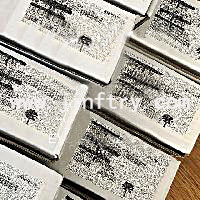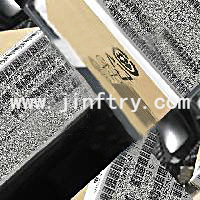How to Read Resistors - Color Codes, Types, Functions, Applications Introduction to 1K-10K Ohm Resistors
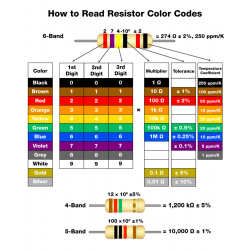
How to Read Resistors - Color Codes, Types, Functions, Applications Introduction to 1K-10K Ohm Resistors
Introduction to Resistor Color Codes:
The color code for resistors is a standardized system for expressing resistance values. Each color represents a specific number, and the color stripes on the resistor provide information about the resistor's resistance value and its tolerance. This color-coding system makes it very simple to identify the resistance value of small, unlabeled resistors.
The following are color-based resistor value codes:
Black - 0 Brown - 1 Red - 2 Orange - 3 Yellow - 4 Green - 5 Blue - 6 Purple - 7 Gray - 8 White - 9
To determine the resistor value, you usually need to consider the first two colored stripes (these two stripes represent numbers that form a two-digit number), and the third colored stripe, which represents multiplied by powers of 10. For example, a resistor with stripes of red, purple, and brown in sequence has a resistance value of 27 x 10^1 = 270Ω or 270 ohms.
The color codes for the tolerances are as follows:
Gold - ±5%
Silver - ±10%
Colorless - ±20%
Other Colors - Indicates other tolerance values or manufacturer-specific coding.
Resistor color ring reading skills:
If you can understand the meanings and calculation principles of various color rings used to represent resistance values, tolerances, and even temperature coefficients, then it is not difficult to identify resistor color codes. Below is a simple diagram to explain the resistor color coding rules to you.
Resistors vary in value, shape, and physical size. Virtually all leaded resistors rated up to one watt have a specific combination of color bands that denote their resistance value, tolerance, and even temperature coefficient. There may be three to six color bands throughout the resistor, of which four color bands are the most common. The first few color circles represent the significant digits of the resistance value. Next is a magnification color wheel, which is used to move the decimal point left or right. The color circle at the back represents tolerance and temperature coefficient.
Let's take a look at the color code diagram below and start with some examples:
Resistor color ring reading skills, just look at this picture!

3 or 4 color ring resistors
The first two colored circles represent the first two digits of the resistance value in ohms. On 3-ring or 4-ring resistors, the third colored ring indicates the multiplier. This magnification can change the position of the decimal place to represent any order of magnitude from megohm to milliohm. The fourth color circle represents the tolerance. Remember, the default tolerance is ±20% on a 3-ring resistor without this color band on it.
For general 4-ring resistors
The first ring represents the first number.
The second ring represents the second number.
The third ring represents multiplication by powers of 10 (i.e. the magnification factor).
The fourth ring represents the tolerance of the resistor.
Example: A resistor with a color ring from left to right is red-purple-brown-gold. This means that its resistance value is 2 (red) 7 (purple) times 10 to the power of 1 (brown) = 270 ohms (ohms), with a tolerance of ±5% (gold).
For 5 ring resistors
The first ring represents the first number.
The second ring represents the second number.
The third ring represents the third number.
The fourth ring represents multiplication by powers of 10.
The fifth ring represents the tolerance of the resistor.
5-ring or 6-ring resistors
High precision resistors have an additional color ring to indicate the third significant figure. If your resistor has 5 or 6 color rings, then the third color ring is this color ring, combined with the first and second color rings to represent the number. Continuing to look to the right, the fourth color wheel represents the magnification, and the fifth represents the tolerance. 6-ring resistors are basically the same type as 5-ring resistors, with the extra colored ring indicating reliability, or the temperature coefficient (ppm/K) specification. Taking brown as the most commonly used sixth color ring as an example, every 10°C change in temperature will cause a 0.1% change in resistance value.
Example 1: 1K/1K Ohm Resistor Color Code
The color ring of a 1K ohm (1KΩ or 1000Ω) resistor, taking the resistance accuracy of 5% as an example, if it is a 4-ring resistor,
A 1K Ohm (1 Kiloohm) resistor is typically the largest resistor used with an LED. Any LED that uses a 1K resistor will be dimmed, but lit. 1K ohm resistors are often used for trimming circuits or pull-up/pull-down data pins. A 1K resistor and a 2.2K resistor can be used to form a voltage divider that steps down the 5V to around 3.4V.
Its color ring is: brown black red gold; if it is a 5-ring resistor, its color ring is: brown black black brown gold. As shown below

1K / 1K Ohm Resistor Color Codes
Example 2: 4.7K / 4.7K Ohm Resistor Color Code
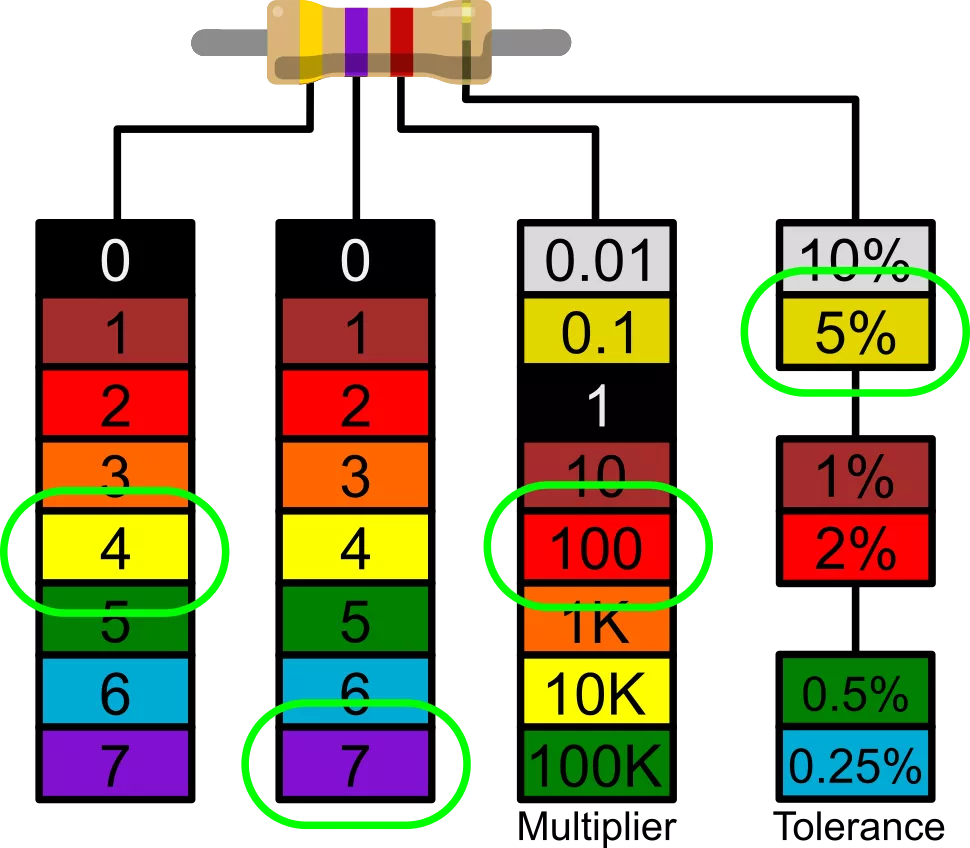
4.7K ohm resistors can be identified by resistor color code yellow-purple-red-gold or yellow-purple-black-brown-gold
Example 3: 10K/10K Ohm Resistor Color Code
10k Ohm Resistor Color Code or 10 kΩ Resistor Color Code. This means the resistor has a value of 10,000 ohms.
In this example we will use resistor color codes for the 4 bands. From the 4-ring resistance color code chart, the first two rings represent numbers, the third ring represents the multiplier, and the fourth ring represents the tolerance. For easier explanation, observe the following table:
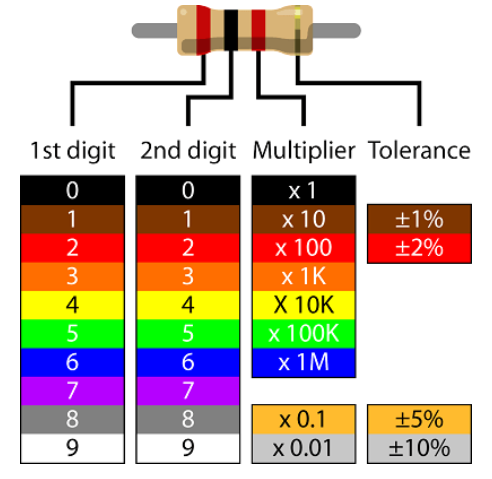
10K Ohm Resistor Color Code
Example 4: 100K / 100K Ohm Resistor Color Code
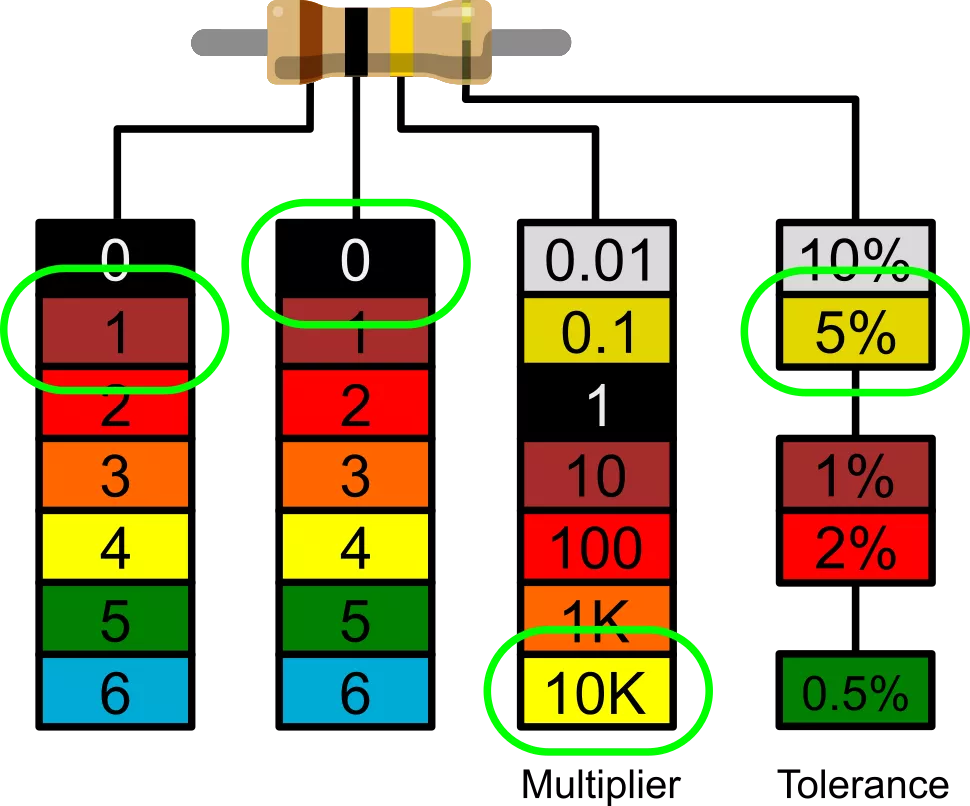
A 100K ohm resistor is the upper limit required by most manufacturers. That's a lot of resistance in a small package, but it has its uses. They are often used as bleeder resistors on capacitors to reduce the risk of severe shoot-through or to tune sensitive audio/video circuits.
For five-ring resistors, the brown-black-yellow-gold or brown-black-black-orange-gold color codes can be used to identify 100K ohm resistors.
Frequently Asked Questions About Resistor Color Codes:
How can I tell which end to start reading the resistor from?
• For many resistors, some of the color rings are more closely spaced or concentrated at one end. Hold the resistor in your hand so that these clustered color rings are oriented to the left. Then read the resistor information from left to right.
• The far left of the resistor can never be a metallic color ring. If the color band at one end of the resistor is gold or silver, then its resistance tolerance is 5% or 10%. Place this resistor so that the color ring is on the right, then read the resistor left to right in the same way.
• Typical resistor values range from 0.1 ohms to 10 megohms. From this it follows that the third color ring of a 4-ring resistor is always blue (106) or a lower value color, while the fourth color ring of a 5-ring resistor is always green (105) or The lower value color.
Why doesn't my high voltage resistor have a metallic color ring?
Yellow and gray replace gold and silver on high voltage resistors to avoid metal particles in their surface coating.
What is a Zero Ohm Resistor?
Zero-ohm resistors are easy to spot with just a black color ring, basically acting as circuit wires to connect to the wiring on the printed circuit board. They are packaged in a similar way to resistors, so the same automated equipment used to place resistors can be used to place them on circuit boards. This design eliminates the need to install jumpers with other equipment.
Is there a trick to memorizing the order of colors in a chart?
While there are some methods on the web to help you with memristor color code charts, the results are mixed. Another way to remember the color table is to think of black as nothing, which is "0", and white as a combination of all colors, which is the highest value "9". In the middle of the color chart, you'll see the standard rainbow colors in order to represent the numbers 2 to 7, which is where the ROY-G-BIV (red orange yellow green blue indigo violet) you learned as a child comes in handy Useful, but the indigo color is missing. You just have to remember that the brown between black and red is for "1" and the gray between purple and white is for "8" and you're done!
What is the "reliability" color wheel?
4-ring resistors in military resistors often have an additional color band to indicate reliability, or failure rate (%) per 1000 operating hours. And that's rarely the case in commercial electronics.
History of Resistor Development
Resistors are the basic components in electrical circuits. After testing the conductivity of various materials and discovering the existence of electric current,
early scientists came to the concept of electrical resistance. Scientists have discovered that copper, gold and aluminum are good conductors with low electrical
resistance, while air, mica and ceramics are considered resistors because they greatly restrict the flow of electrical current. Although its resistive properties were
known in the industry for a long time, the reliable resistor we know today was not born until 1961, when Otis Boykin created the first cheap and reliable resistor,
and scientists were able to precisely control The amount of current delivered to a component. With his breakthrough, resistors are much less susceptible to temperature
extremes and oscillations, ultimately making their low-cost production possible. As the U.S. Army, IBM, and numerous consumer electronics makers place orders for Boykin's new resistors,
they're found in everything from home appliances and computers to guided missiles.
Resistors are ubiquitous in today's electronics. As passive devices, they only consume but never provide energy.
They are used in a wide variety of circuits, for example, to regulate the current input to an LED, or to control the total voltage delivered to an active
device such as a transistor. Resistors can be used to block transmission lines and prevent reflections, or they can also be used as pull-up or pull-down resistors
in microcontroller GPIOs to increase system stability. A combination of resistors and capacitors can create the timing sources necessary for flashing lights or electronic alarm circuits.
A "daisy-chain" of resistors in series acts as a voltage divider, which is useful for components that need to operate at a lower voltage than the input.
Resistance color ring
How To Read Resistor Color Code Video Instructions For 3/4/5/6 Ring Resistors:
The EIA (Electronic Industries Alliance) standard defines a series of values for resistors, the E12, E24, E48, E96, and E192 series are common.
The following are benchmark values for the EIA's E12, E24 and E96 series, which are ten-year resistor series values:
E12 Standard Resistor Series (±10% Tolerance):
1.0, 1.2, 1.5, 1.8, 2.2, 2.7, 3.3, 3.9, 4.7, 5.6, 6.8, 8.2
E24 Standard Resistor Series (±5% Tolerance):
1.0, 1.1, 1.2, 1.3, 1.5, 1.6, 1.8, 2.0, 2.2, 2.4, 2.7, 3.0, 3.3, 3.6, 3.9, 4.3, 4.7, 5.1, 5.6, 6.2, 6.8, 7.5, 8.2, 9.1
E96 Standard Resistor Series (±1% Tolerance):
1 Ohm Resistor Color Code 4 Ring Resistors are Brown - Black - Gold - [Tolerance].
The color code for the 1 ohm resistor 5 rings is BROWN - BLACK - BLACK - SILVER - [TOOLER].
10 Ohm Resistor Color Code 4 Ring Resistors are Brown - Black - Black - [Tolerance].
10K Ohm Resistor Color Code 4 Ring Resistors are Brown - Black - Black
The color code for the 5-ring 10 ohm resistors is Brown-Black-Black-Gold-[Tolerance].
The 100 ohm resistor color code for the 4-ring resistors is Brown-Black-Brown-[Tolerance].
The color code for the 5-ring 100 ohm resistors is Brown-Black-Black-Black-[Tolerance].
The 1k resistor color code for 4-ring resistors is Brown-Black-Red-[Tolerance].
1k ohm resistor color code 5 rings (that is, 1000 ohm resistor color code 5 rings) is brown-black-black-brown-[tolerance].
1K Ohm resistor color code The color ring is: brown black red gold; if it is a 5-ring resistor, the color ring is: brown black black brown gold
The 10k resistor color code for 4-ring resistors is Brown-Black-Orange-[Tolerance].
The color code for the 5-ring 10k ohm resistors is Brown-Black-Black-Red-[Tolerance].
100k Ohm Resistor Color Code for 4 Ring Resistors is Brown - Black - Yellow - [Tolerance].
The color code for the 5-ring 100k ohm resistors is Brown-Black-Black-Orange-[Tolerance].
1M Ohm Resistor Color Code for 4 Ring Resistors is Brown - Black - Green - [Tolerance].
The color code of the 5-ring 1M ohm resistor is Brown-Black-Black-Yellow-【Tolerance】.
10M Ohm Resistor Color Code for 4 Ring Resistors is Brown - Black - Blue - [Tolerance].
The color code for the 5-ring 10M ohm resistors is Brown-Black-Black-Green-[Tolerance].
The color code for the 1.01 ohm resistors is Brown-Black-Brown-Silver-[Tolerance].
The 1.02 ohm resistor color code for 5-ring resistors is Brown-Black-Red-Silver-[Tolerance].
1.04 Ohm 5-ring resistors color code Brown-Black-Yellow-Silver-[Tolerance].
The color code for the 5-ring 1.05 ohm resistors is Brown-Black-Green-Silver-[Tolerance].
1.06 Ohm Resistor Color Code Brown - Black - Blue - Silver - [Tolerance].
120 Ohm Resistor Color Code Brown-Red-Brown-Gold-[Tolerance].
150 Ohm Resistor Color Code Brown-Green-Brown-Gold-[Tolerance].
2.2k Resistor Color Code 4 Rings are Red - Red - Red - [Tolerance].
2.2k Ohm Resistor Color Code 5 Color Bands are Red-Red-Red-Gold/Silver.
20k ohm resistor color code is red-black-orange-gold
220 Resistor Color Code 4-Ring Resistors are Red-Red-Brown-[Tolerance] (Gold is 5% Tolerance, Silver is 10% Tolerance).
The 5-segment color code for 220 ohm resistors is red-red-black-black-[tolerance].
The color code of the 20k resistor is red-black-orange-[tolerance].
22k Resistor Color Code 4 Rings are Red-Red-Orange-[Tolerance].
2200 ohm resistor color code 5 segments are red-red-black-red-[tolerance].
330 ohm resistor color code for 4-ring resistors is Orange-Orange-Brown-Gold (5% tolerance).
3.3 k Resistor Color Code 4 Rings are Orange-Orange-Red-Gold.
3.3k resistor color code 5 segments are orange-orange-black-brown-[tolerance].
The 33k resistor color code is orange-orange-orange-gold.
The 470 ohm resistors are color coded Yellow-Purple-Brown-Gold.
The 15k resistor color code is brown-green-orange-gold.
47K Resistor Color Code 4 Rings are Yellow - Purple - Orange - [Tolerance].
The 5 color rings of the 47k resistor color code are yellow-purple-black-red-[tolerance].
4.7k Ohm Resistor Color Code 4 Color Ring is Yellow - Purple - Red - [Tolerance].
4.7 k Resistor Color Code 5 color ring is Yellow-Purple-Black-Brown-[Tolerance].
50 Ohm Resistor Color Code Brown - Red - Orange - [Tolerance]
The 500 ohm resistor color code is green-brown-brown-[tolerance] (500 ohm resistor is a non-standard value resistor, so please use the 510 ohm resistor color code.)
The 5.6k resistor color code (also the 5k6 ohm resistor color code) is Green-Blue-Red-[Tolerance].
The color code of 6k8 ohm resistors (that is, the color code of 6.8k resistors) is blue-gray-red-[tolerance].
500 Ohm Resistor Color code is Green (5) Black (0) Brown (1) Gold (±5%)
510 Ohm Resistor Color Code Green, Brown, Brown, Gold
edit author:

Jinftry(Hong Kong registered company name: JING FU CAI (HONGKONG) INTERNATIONAL CO., LIMITED) was established in 2013, headquartered in Hong Kong, China, with a branch in Shenzhen, China. It is a global supplier of electronic components and a well-known and competitive electronic product distributor in Asia. Is also an excellent strategic partner of global ODM/OEM/EMS, able to quickly find authentic and traceable electronic components for customers to purchase.


